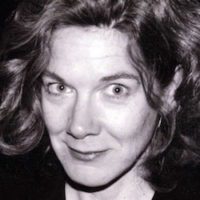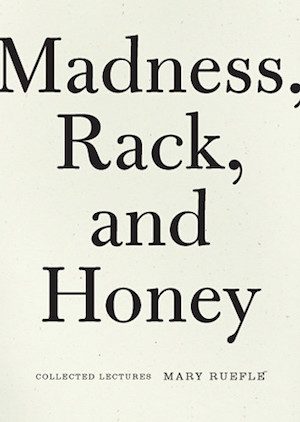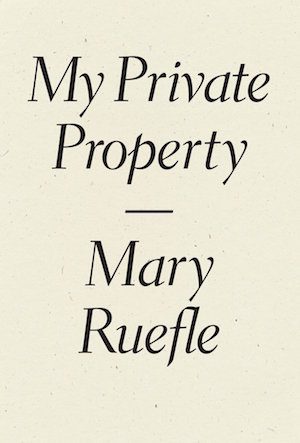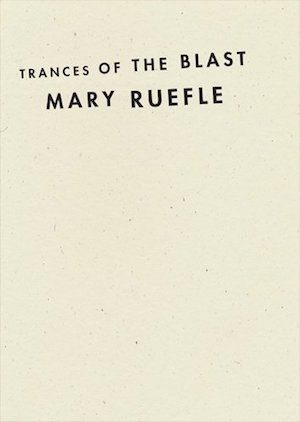1: Snowflakes
When I think of Mary Ruefle, I think of glitter hanging suspended in the air—as if time had stopped exactly when a shower of so many small, flat, reflective particles was beginning its downward descent and all I had to do was walk around and admire this beautiful frozen instant sending unexpected rays of light in every which way.
I think of this image because one snowy afternoon, after a long summer of passersby carrying copies of Madness, Rack, and Honey: Collected Lectures, I walked out of a cold, white bookstore with a slim volume of poetry, its cover even more featureless than the landscape I was stepping into: Trances of the Blast. In a coffee shop, warming my half-frozen nose with the steam of hot chocolate, I opened the book and flipped to its first poem, “Saga”:
Everything that ever happened to me
is just hanging—crushed
and sparkling—in the air,
waiting to happen to you…
For days afterwards, I could not stop imagining the snowflakes coming down as crushed and sparkling portions of Mary Ruefle’s life. If one of those flakes landed on my eyelids and melted, what would happen? Or dissolved on my tongue and snaked down my throat?
2: Martianism
“The Woman Who Couldn’t Describe a Thing if She Could” is the title of one piece in Mary Ruefle’s new prose collection, My Private Property. Another is “One Girl’s Theory.” Later on, there is “Outcast.” And further on is “Self-Criticism.” If she is writing these short texts about herself—and indeed we might be forgiven for thinking so—she paints herself critically, as if she found herself completely foreign. When this happens, reading Mary Ruefle’s stories becomes a game in which we try to figure out the rules she is writing by: what does she know, what does she not, what do we know, what do we not, how do we see this in her words…
This intense defamiliarization is contagious, infecting every element it touches; just as it turns Mary into a Martian, so it turns us into aliens peering at the strange world upon which we live: “The planet seen from extremely close up is called the ground,” one piece begins. “The ground can be made loose by the human hand, or by using a small tool held in the human hand…”
3: Without Any Warning
“Poor little keys!” goes one of Mary Ruefle’s pieces, this one about unwarranted hurdles to unlocking doors everywhere. Whatever happened to humor like this? I spend all week wading into books full of sadness and despair and realism, and in everything I read I find sameness. The places are different, the people are different, but the feelings are the same, the endings are the same.
And then, without any warning, Mary Ruefle happens.
There are sentences in My Private Property that have me bent over laughing at the sheer absurdity we experience in every ho-hum day. Keys that insist on lives of their own (“the key’s feelings were those of a snail being pulled from its shell”) or apathetic schoolboys holding to-be-read copies of Melville’s Bartleby and insisting, boredly, “I would prefer not to,” or the comic setup of the narrator sprinkling salt and pepper into her buddy’s milkshake while she’s gone to the restaurant bathroom. What are we all if not silly little creatures who find in everything new sources of silliness?
4: ![]()
But sadness is no more distant than happiness and silliness. There are many kinds of sadness in My Private Property, and each one is marked not with a title but with a typographic ornament: ![]() . In the table of contents, there are no typographical ornaments, but there are colors: Blue, Purple, Black, Gray, Red, Green, Pink, Orange, Yellow, White, Brown. The images each text offers are enigmas waiting for their decrypters: “Red sadness never appears sad, it appears as Nijinsky bolting across the stage in mid-air”; “Sad to say, gray sadness is replaceable, it can be replaced daily”; “pink sadness is not your fault”; “Blue sadness is sweetness cut into strips with scissors and then into little pieces by a knife…”
. In the table of contents, there are no typographical ornaments, but there are colors: Blue, Purple, Black, Gray, Red, Green, Pink, Orange, Yellow, White, Brown. The images each text offers are enigmas waiting for their decrypters: “Red sadness never appears sad, it appears as Nijinsky bolting across the stage in mid-air”; “Sad to say, gray sadness is replaceable, it can be replaced daily”; “pink sadness is not your fault”; “Blue sadness is sweetness cut into strips with scissors and then into little pieces by a knife…”
And happiness is no more distant than silliness and sadness. At the very end, in an Author’s Note, Mary Ruefle has offered the little tidbit of advice: “In each of the color pieces, if you substitute the word happiness for the word sadness, nothing changes.”
5: One Consideration of How She Surpasses Lydia Davis
If I set a story by Mary Ruefle—let’s say “To a Magazine,” the story that begins with the sentence “I am rejecting your request for a letter of rejection”—next to a story by Lydia Davis—let’s say “A Few Things Wrong With Me,” the story that begins with the sentence “I didn’t like hearing there were things about me that bothered him”—a harried grad student in, let’s say, Early Twenty-First-Century Short American Fiction, might peer at both stories, clear her throat, and misattribute them both to the same author as she embarks upon her exposition of each text. She would talk about the peculiar pleasures found in small everyday objects and motions. She would consider the way language becomes a toy, a little clockwork contraption that can be disassembled and investigated within these pieces. She would consider the calmness that betrays emotional furor.
But Lydia Davis, brilliant as she always is, confines her literary process to the quiddities of reality. Often, yes, there is emotional weight behind the seemingly mundane instants engraved in her prose—but that is all. A thing has happened, and then she and we go on in our humdrum lives, a smidge more attentive, but hardly transformed.
Mary Ruefle, on the contrary, scrutinizes reality, reveals emotional depths beneath, and then somehow finds a greater weight beneath. A short story, in Mary Ruefle’s hands, is not simply a snapshot of our world made permanent with words; it leaves a fiery trace on our unsuspecting minds; it works on another level.
6: An Anagogical Level
An anagogical level, as Joy Williams so succinctly put it. The medieval theologians posited literal, allegorical, and moral senses in interpreting texts, and beyond those three a fourth and ultimate spiritual or mystical sense. In the first story of My Private Property, the narrator tells her companions that “in the beginning you understand the world but not yourself, and when you finally understand yourself you no longer understand the world.” In between is the long corridor of exploration and exegesis. Maybe it isn’t fair to ask this spiritual element of every writer, but when pressed Mary Ruefle proves her mettle with panache. “You haven’t even begun,” she admonishes the younger version of ourselves. “You must pause first, the way one must always pause before a great spirit, if only to take a good breath.”
7: A Monologue about What Is Missing from Art These Days
Some years ago, on the front lawn of a yellowed and yellowing house in New Haven, my friend, a woman much older than me, sat on the grass and gave a monologue about what was missing from art these days. We were at her house because a famous artist, who once had been her roommate from college, had now come to give a lecture about her own work. The famous artist went inside to wash her hands and my friend kept on talking. “Take Roni Horn. Roni is brilliant, but she’s so cold. Half of her work is so intellectual that there’s almost joy in actually looking at it. But I think Paula fixes that to some degree. She’s willing to be organic, to explore the full range of color. There’s a tactile quality to her art, and I’m glad that she works in so many different forms. It gives us a way to understand what commonalities and obsessions persist across her output. It’s the kind of art that I want to touch and hold and keep.” Other people started arriving for dinner and we walked into the house. In her living room, she gestured to a large painting that Paula had done and ended her monologue on this thought: “Even if we weren’t friends, I would still be collecting her work because I think it’s an œuvre that cares about, puts value on an aspect that seems to be missing from art these days: beauty.”
8: Mary Ruefle’s Private Property
So this is what we have come to, some readers think to themselves halfway through My Private Property. We are reading the thoughts of a woman who comes to know herself more and more as she gets older, and who in so doing comes to know the world less and less. The title piece, “My Private Property,” is a miniscule tour de force of reminiscence, binding together thoughts on shrunken heads and how they are made (“miniaturizing and preserving a human head is a glory and wonder on the scale of the Great Pyramids”), the strange caprices and reversals of fortune, Ruefle’s escape into a museum of the Congo during her childhood in Brussels, the question of whether or not a shrunken head is a real person (there, as everywhere, we find the anagogical level inherent in Ruefle’s visions), the relationship between the living and the dead, the physical indignities Ruefle’s mother bore as she neared death, and Ruefle’s wish to own “as my personal private property, twelve human heads.” Nowhere is the connection explicitly made, but it would not be wrong to infer that the 105 pages of My Private Property, each one containing a crushed and sparkling portion of her life and her mind, is the textual equivalent of a shrunken head: much as the Jivaro, or Shuar, Indians go through a complicated multi-day process to shrink something the size of a volleyball down to the size of an orange, so does Mary Ruefle condense her thoughts and worldview into a small collection of texts and prose fragments that fit snugly in our hand. And what do we see as we hold this small book open? We see a woman laid bare, the wide landscape of her life compressed into small glittering objects hanging in the air, and as we peer at these small, flat, reflective particles, we see mirrored back at us our own faces, the broad mosaic of our lives, and, beyond, a way out into the future that awaits each of us.







